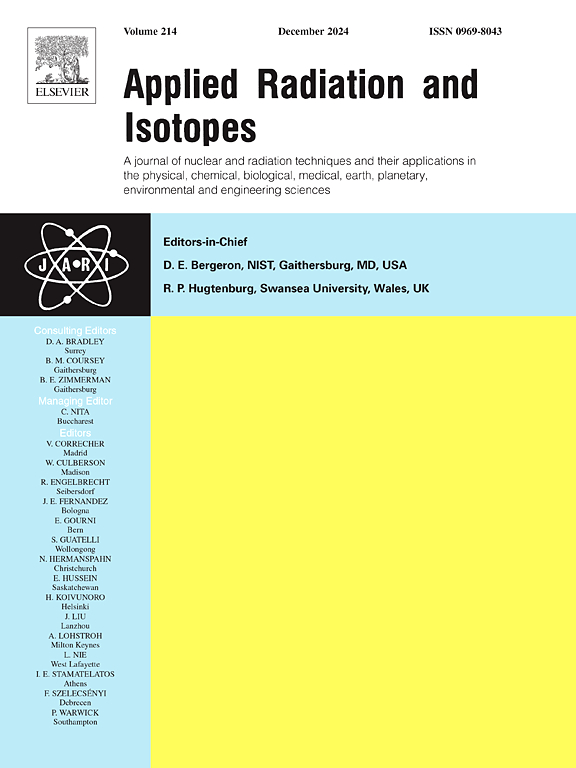利用弹道凝胶作为组织替代物,对用于白细胞校准的新型 3D 打印模型进行蒙特卡洛建模和模拟。
IF 1.6
3区 工程技术
Q3 CHEMISTRY, INORGANIC & NUCLEAR
引用次数: 0
摘要
全身计数器(WBC)系统用于职业内剂量测定中的活体监测,通常使用物理拟人模型进行校准。我们的研究小组先前 3D 打印了不含内脏器官的内剂量测定参考女性模型(RFPID),专门用于 WBC 校准。我们打算在 RFPID 中均匀填充弹道凝胶,弹道凝胶通常用作弹道研究中的等效组织。然而,对其作为剂量测定的组织替代物的理化特性和放射行为的全面描述还很有限。本研究旨在评估弹道凝胶作为物理模型的组织替代物在白细胞计数系统校准中的适用性,并分析作为白细胞计数校准模型的 RFPID。弹道凝胶测试确定了其密度和衰减系数,并将其与肌肉、水和 PMMA 进行了比较。使用 MCNP6.2 代码对 RFPID 进行了建模和模拟,并将其放置在体内监测系统中,该系统使用的是先前经过验证的 8 "x4″ NaI(Tl)闪烁体探测器。使用 ICRP-110 的 RCP_AF 重复进行了模拟。结果表明,弹道凝胶的密度与肌肉相差约 6%,在中高能量水平(186-2200 千伏)显示出与肌肉相似的线性衰减系数。模拟结果表明,在 100 至 3000 千伏的能量范围内,RFPID 和 RCP_AF 的计数效率相差不到 9%,这证实了该模型适用于白细胞校准,以及弹道凝胶在内部剂量测定中作为组织替代物的可行性。本文章由计算机程序翻译,如有差异,请以英文原文为准。
Monte Carlo modeling and simulation of a new 3D printed phantom for WBC calibration with ballistic gel as a tissue substitute
Whole-body counter (WBC) systems are used for in vivo monitoring in occupational internal dosimetry, typically calibrated using physical anthropomorphic phantoms. Our research group previously 3D-printed the Reference Female Phantom for Internal Dosimetry (RFPID) without internal organs specifically designed for WBC calibration. The RFPID and it is intended to fill it homogenously with ballistic gel, which is commonly used as a tissue equivalent in ballistic studies. However, comprehensive characterization of its physicochemical properties and radiological behavior as a tissue surrogate for dosimetry is limited. This study aims to evaluate the suitability of ballistic gel as a tissue substitute for physical phantoms in WBC system calibration and to analyze the RFPID as a model for WBC calibration. Ballistic gel tests determined its density and attenuation coefficients, comparing it to muscle, water, and PMMA. The RFPID was modeled and simulated using MCNP6.2 code and placed in an in vivo monitoring system using an 8”x4″ NaI(Tl) scintillator detector previously validated. The simulations were repeated with the RCP_AF of ICRP-110. Results indicate that ballistic gel has a density approximately 6% different from muscle and shows similar linear attenuation coefficients to muscle at intermediate and high energy levels (186–2200 keV). Simulations revealed a disparity of less than 9% in counting efficiency between RFPID and RCP_AF for energies from 100 to 3000 keV, confirming the phantom's suitability for WBC calibration and ballistic gel's viability as a tissue surrogate in internal dosimetry.
求助全文
通过发布文献求助,成功后即可免费获取论文全文。
去求助
来源期刊

Applied Radiation and Isotopes
工程技术-核科学技术
CiteScore
3.00
自引率
12.50%
发文量
406
审稿时长
13.5 months
期刊介绍:
Applied Radiation and Isotopes provides a high quality medium for the publication of substantial, original and scientific and technological papers on the development and peaceful application of nuclear, radiation and radionuclide techniques in chemistry, physics, biochemistry, biology, medicine, security, engineering and in the earth, planetary and environmental sciences, all including dosimetry. Nuclear techniques are defined in the broadest sense and both experimental and theoretical papers are welcome. They include the development and use of α- and β-particles, X-rays and γ-rays, neutrons and other nuclear particles and radiations from all sources, including radionuclides, synchrotron sources, cyclotrons and reactors and from the natural environment.
The journal aims to publish papers with significance to an international audience, containing substantial novelty and scientific impact. The Editors reserve the rights to reject, with or without external review, papers that do not meet these criteria.
Papers dealing with radiation processing, i.e., where radiation is used to bring about a biological, chemical or physical change in a material, should be directed to our sister journal Radiation Physics and Chemistry.
 求助内容:
求助内容: 应助结果提醒方式:
应助结果提醒方式:


